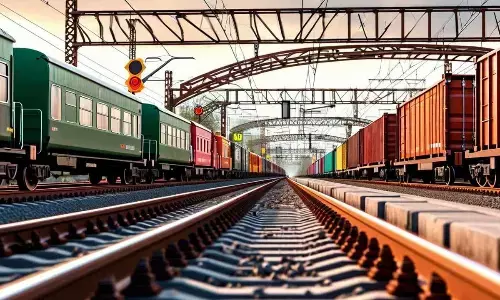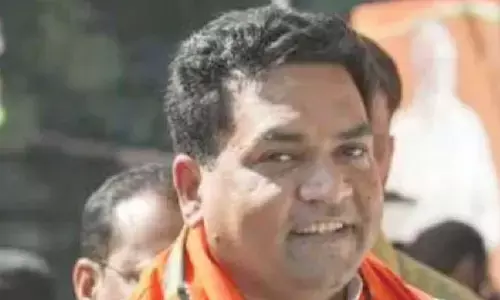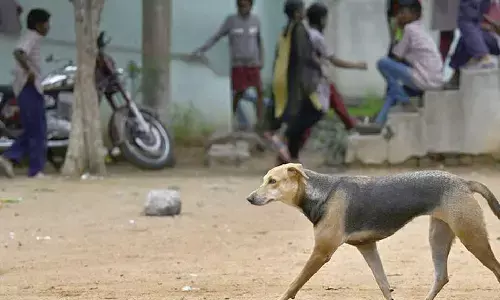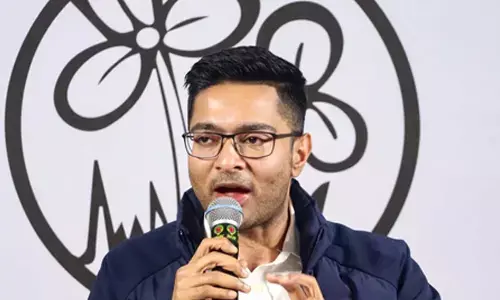Just hype, no allocations
Allocations not truly reflecting the claims characterise the Budget estimates for the financial year 2018-19. Thus, the budget estimates devoid of fiscal allocations will only end up as election eve rhetoric rather than effecting any change in the state of economy or conditions of the people.
Allocations not truly reflecting the claims characterise the Budget estimates for the financial year 2018-19. Thus, the budget estimates devoid of fiscal allocations will only end up as election eve rhetoric rather than effecting any change in the state of economy or conditions of the people.
Whither agriculture
The avowed focus of this year's budget is agriculture. The adverse results in rural Gujarat might have prompted the finance minister to levy such an emphasis on agriculture and rural sector in his budget speech. But, what is the real picture when it comes to allocations.
Lavish pronouncement of commitments for development of agriculture and rural development along with launching so many schemes, were not backed up by appropriate budgetary allocations. The Agriculture and Allied Services and Rural Development got only a marginal increase of Rs 9793 crore in nominal term meaning actually a decline both in real terms and also as a percentage of GDP and total budgetary allocations.
The finance minister further claimed that the government has declared Minimum Support Price (MSP) for the majority of rabi crops at least at one and a half times the cost involved. The finance minister said, "Now, we have decided to implement this as a principle for the rest of crops.
But, The All India Kisan Sangharsh Coordination Committee (AIKSCC), an umbrella forum of over 180 farmers’ organisations, has calculated that for the top seven crops in the kharif season this year, farmers got prices that were less than PM Modi’s promise by a whopping Rs 2 lakh crore. The seven crops studied were paddy, maize, soybean, cotton, bajra, groundnut and urad.
The finance minister spoke about a suitable mechanism to implement BJP’s promise that farmers should realise at least 50 per cent more than the cost of their produce. But he failed to make any allocation for this purpose of market intervention or setting up a price stabilisation fund.
Health hoax
The government wanted to ensure health and wellness of the people through 1.5 lakh health centres to bring health care system closer to the homes of people. These centres will provide comprehensive healthcare, including for non-communicable diseases and maternal and child health services, free essential drugs and diagnostic services. But, the finance minister has committed only Rs 1,200 crore in this budget for this flagship programme. This works out to Rs 80,000 per centre per year. This is a classic illustration of how the allocations do not match the stated objectives of the schemes.
The Union Budget 2018 has unveiled a universal health insurance coverage scheme with zero allocations at least in the Budget speech. The Budget has launched a flagship National Health Protection Scheme to cover over 10 crore poor and vulnerable families (approximately 50 crore beneficiaries) providing coverage up to Rs 5 lakh per family per year for secondary and tertiary care hospitalisation. This is certainly aspirational.
But, why did the FM fail to mention any allocation for the scheme in the Budget speech. The FM has only said that adequate funds will be provided. The budgetary allocation on this account is merely Rs 1600 core which can cover hardly 10 lakh families (and not 10 crore). This is nothing but a cruel hoax on people of India.
There has been a small increase of Rs 1249 cr in the total budget for health and family welfare. In fact, the allocation under National Health Mission (NHM) has been reduced and on ICDS and MDM there are marginal increase that too for other expenditures.
Gender budget
The size of the ‘Gender Budget’ has also contracted, despite the Finance Minister’s statement that ‘agriculture and rural sector’ and ‘women’s employment and health’ were some of the main priorities of this year’s budget.
The total Gender Budget has declined from 0.69% of the revised GDP for 2017-18 to 0.65 per cent of the projected GDP for 2018-19. There has also been a decline from 5.2 per cent to 4.9 per cent in terms of the proportion of the Gender Budget to the total budgetary expenditure between 2017-18 (revised estimates) and the proposed budget for 2018-2019. As far as the allocations for the Ministry of Women and Child Development are concerned, it has been increased from 0.95% of the total expenditure in the revised estimates of 2017-18 to 1.0 per cent of the total projected expenditure for 2018-19.
The gender specific allocation for women farmers is only 3.92 per cent of the entire gender budget (that is an increase of a paltry 0.63 per cent in one year).
The budget proposed to set up 22000 ‘Gramin Haats’ so that ‘farmers can directly sell to the buyers’. The budget also projects that this will be facilitated through farmers’ producer firms and women’s self-help groups. This huge challenge is to be met by an overall paltry increase of Rs 1400 Cr in the National Rural Livelihood Mission of which the women’s share is 50 per cent.
Cruel joke
Employment generation is claimed to be one of the focus areas of this budget. The government intends to boost employment through measures like skill development, increase in self-employment, support to medium and small enterprises, and the use of MNREGA for building infrastructure.
But, none of these claims are backed by adequate allocations. The allocation for MNREGA remains the same as the Revised estimate of 2017-18 at Rs 55000 Cr. The Gender Budget in MNREGA remains stagnant at Rs 18333.33 crore. Further, the allocations for medium and small scale enterprises (MSME) has only gone up by Rs 85 cr in the entire budget whereas the allocation for Skill Development and Livelihood generation has in fact decreased by Rs 33 crore in the last year.
Hollow claims
The food subsidy to the Food Corporation of India has gone up by 20.7 per cent which is just about enough to meet its rising establishment costs. However, the allocations for procurement of food under the National Food Security Act has declined by Rs 7000 cr and the sugar subsidy has come down by Rs 100 cr. Hence, the apparent increase in food subsidy is not substantive in nature. At the same time the crucial Mid Day Meal Scheme has only seen an abysmal increase of Rs 500 Cr, and the ICDS scheme has seen an increase of just about Rs 1090 cr which again is not a substantive increase. The government has also allocated a paltry Rs 3.34 cr for the much hyped Ujjwala Yojana.
The proportion of expenditure in education has come down from 2.1% to 2.0% of the total expenditure. The expenditure on Sarva Shiksha Abhiyan has decreased from 47.9 % to 46.3% of the education expenditure in the last one year. Further, there is virtually no allocation for the Ekalavya Vidyalayas and there is no mention of any increase in education infrastructure. In this context it is also important to note that the allocations for educational schemes for the girl child have decreased by Rs 64.1 cr. There has been a paltry increase of Rs 80 cr in the flagship Beti Badhao Beti Padhao Scheme.
Incremental welfare
The Nirbhaya Fund remains at Rs 500 Cr. The government plans to expand the Swachh Bharat Abhiyan, but the actual allocation for the Abhiyan has decreased by Rs 1655. 17 cr. Further, even after the hype, only a paltry Rs 3400 cr was spent on the Abhiyan last year. This means that open defecation free villages will remain a long term dream.
The total outlay for the department for the empowerment of persons with disabilities shows a marginal increase of Rs 215 crore as compared to last year. The allocation towards Schemes for the Implementation of the Persons with Disabilities Act (SIPDA) is a mere Rs 300 crore. This includes provision for the much touted ‘Accessible India’ campaign under which the target set is for making 600 public buildings accessible, 600 official websites accessible and making transport systems accessible among others.
The allocation for Schedule Caste welfare is just Rs 56000 crore as against Rs 52000 crore in last year's budget. It failed to implement Narendra Jadhav Committee recommendation as it should be 4.5% allocation for SC welfare in total budget. But in this budget, it is 2.3% only.
Woman injured in stabbing attack in Tokyo, suspect at large
Bengal cop booked for murder over mysterious death of woman home guard, SIT to probe case
Staffer recalls horror of 7-kg gold robbery by armed gang in Karnataka’s Hunsur
25-Year-Old Airline Cabin Crew Member Dies At Gurugram Party; Police Begin Investigation

















